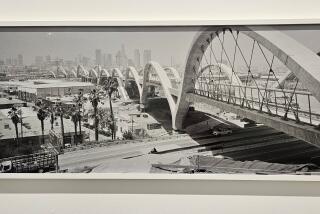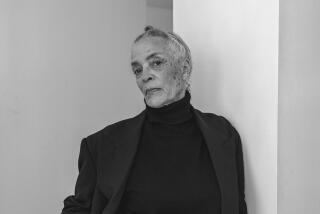Review: Laura Lancaster paintings are the most magical of Rorschach tests
If you’ve ever wielded a paintbrush in the service of art, you’ll appreciate the fluidity and deftness of Laura Lancaster’s brushwork. The British artist, in her first L.A. solo exhibition at Night Gallery, makes big, lush paintings that teeter between figuration and abstraction.
Her subjects are classic — women, paired with mirrors or water — but the results feel more like Abstract Expressionism, or perhaps a more extreme form of Impressionism. Whichever “-ism” you prefer, the works are moving meditations on the vicissitudes of vision, memory and time.
GRACIELA ITURBIDE: Arresting photos of Mexico from a legendary eye »
The works begin as photographs, from which Lancaster makes pastel drawings. The final paintings are created from the pastels, representing two stages of abstraction. If a photograph is a snapshot of a moment, these paintings are like an echo: a memory only faintly recalled.
“Ghost” is a grayscale painting that at first looks wholly abstract, but eventually it resolves into the barest suggestion of a ponytailed woman, seated before a milky vanity. Searching for this figure amid Lancaster’s broad, confident brushstrokes is something like a Rorschach test. The gradual revelation feels magical.
The figures in “Untitled” are slightly more distinct: two pale-skinned bodies floating in the water. Their contours are nothing but broad smears of paint, but somehow Lancaster manages to coax a sense of presence and specificity from the tangle.
“Nowhere” is even more impressive. Amid looping, drippy strokes of pale blue, ochre, orange and white over a dark ground, we’re surprised by the barest suggestion of a black face emerging from the tumult. It’s marvelous how Lancaster creates such a startling presence — once seen, you can’t unsee it — with such economy of means.
I was reminded of Abstract Expressionist Joan Mitchell, whose loose, energetic brushwork conjured rapturous landscapes. L.A. artist Mary Weatherford also comes to mind, attuned as she is to the poetics of place. Lancaster applies this atmospheric approach to the figure, an effort that might also be compared to the awkward ballerinas of Edgar Degas: body parts emerging from a flurry of tutus.
The experience of searching, and the pleasure of finding, are delicious. The work evokes memory: the way a thought or image is recalled from the stream of experience, to crystallize, if only for a moment.
Night Gallery, 2276 E. 16th St., L.A. Tuesdays-Saturdays, through May 25. (323) 589-1135, www.nightgallery.ca
See all of our latest arts news and reviews at latimes.com/arts.
More to Read
The biggest entertainment stories
Get our big stories about Hollywood, film, television, music, arts, culture and more right in your inbox as soon as they publish.
You may occasionally receive promotional content from the Los Angeles Times.






